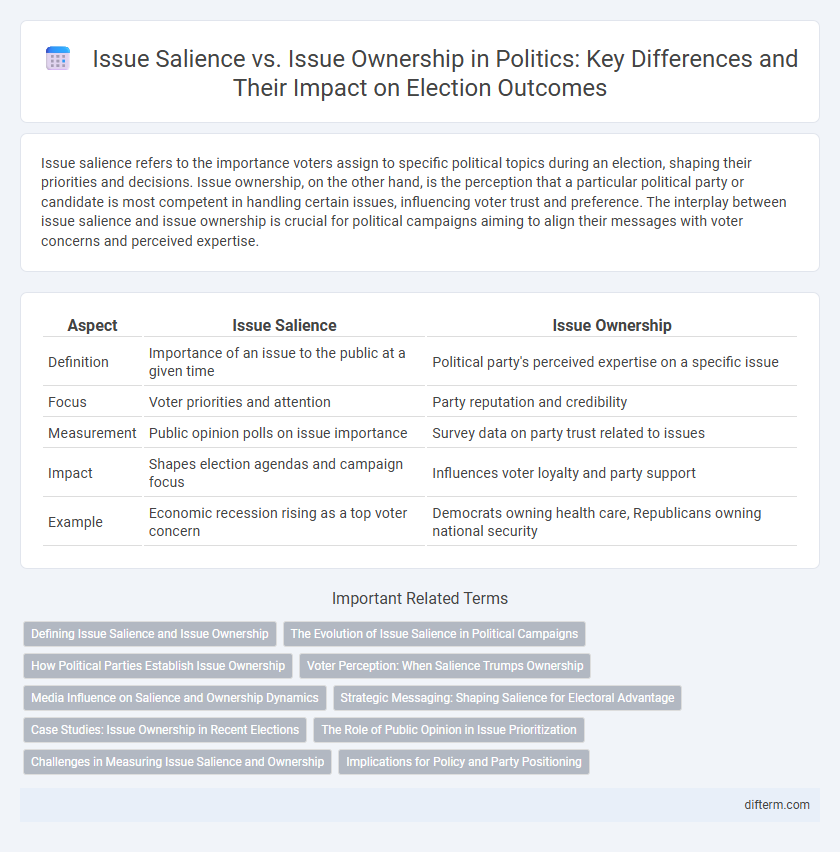Issue salience refers to the importance voters assign to specific political topics during an election, shaping their priorities and decisions. Issue ownership, on the other hand, is the perception that a particular political party or candidate is most competent in handling certain issues, influencing voter trust and preference. The interplay between issue salience and issue ownership is crucial for political campaigns aiming to align their messages with voter concerns and perceived expertise.
Table of Comparison
| Aspect | Issue Salience | Issue Ownership |
|---|---|---|
| Definition | Importance of an issue to the public at a given time | Political party's perceived expertise on a specific issue |
| Focus | Voter priorities and attention | Party reputation and credibility |
| Measurement | Public opinion polls on issue importance | Survey data on party trust related to issues |
| Impact | Shapes election agendas and campaign focus | Influences voter loyalty and party support |
| Example | Economic recession rising as a top voter concern | Democrats owning health care, Republicans owning national security |
Defining Issue Salience and Issue Ownership
Issue salience refers to the prominence or importance of a political issue to the public or specific groups at a given time, influencing voter priorities and campaign strategies. Issue ownership describes the association of particular political parties or candidates with specific issues, establishing credibility and trustworthiness in those areas. Understanding the dynamic between high issue salience and perceived issue ownership critically shapes electoral outcomes and policy debates.
The Evolution of Issue Salience in Political Campaigns
Issue salience in political campaigns evolves as voter priorities shift due to economic conditions, social movements, and media influence, affecting which topics dominate public discourse. Issue ownership, the perceived competence of a party on specific issues, interacts with changing salience, shaping campaign strategies and voter alignment. This dynamic reflects how parties must adapt to emerging concerns to maintain relevance and electoral success.
How Political Parties Establish Issue Ownership
Political parties establish issue ownership by consistently emphasizing specific policy areas that align with their ideological strengths and voter base concerns. Strategic communication, targeted campaigning, and persistent agenda-setting in media and legislative priorities reinforce the perception that a party is the authoritative advocate for particular issues. This process enhances issue salience by shaping public awareness and linking the party's identity with the prioritized issues, thus influencing voter behavior and electoral outcomes.
Voter Perception: When Salience Trumps Ownership
Voter perception shifts notably when issue salience outweighs issue ownership, as urgent or highly relevant problems can redefine political priorities irrespective of traditional party associations. Political parties may lose their advantage on specific issues if public concern intensifies, prompting voters to prioritize current needs over established expertise. Empirical studies reveal that during crises, such as economic recessions or public health emergencies, heightened issue salience disrupts conventional ownership, reshaping electoral outcomes.
Media Influence on Salience and Ownership Dynamics
Media influence plays a critical role in shaping issue salience by highlighting specific topics, thereby increasing public attention and urgency. It also affects issue ownership by framing political parties or candidates as the most competent on those highlighted issues through persistent coverage. The interaction between media framing and agenda-setting mechanisms creates dynamic shifts in both public perception and political strategy concerning issue prominence and credibility.
Strategic Messaging: Shaping Salience for Electoral Advantage
Strategic messaging leverages issue ownership to amplify issue salience, ensuring voters prioritize topics where a party holds credibility. By emphasizing owned issues through targeted communication, campaigns shape public perception to align with their strengths, increasing electoral appeal. This approach maximizes voter engagement on salient issues, enhancing the likelihood of electoral success.
Case Studies: Issue Ownership in Recent Elections
Issue ownership significantly influenced voter behavior in recent elections, with parties capitalizing on traditionally strong policy areas such as the economy for conservatives and healthcare for progressives. Case studies from the 2020 U.S. presidential election and the 2019 UK general election demonstrate how candidates reinforced their association with high-salience issues to mobilize core supporters. Data shows that parties effectively leveraging issue ownership often achieve a measurable boost in electoral performance by aligning campaign messaging with voter priorities.
The Role of Public Opinion in Issue Prioritization
Issue salience determines which political issues capture public attention and influence voter priorities, while issue ownership refers to the association of certain parties or candidates with specific topics based on perceived competence. Public opinion shapes issue prioritization by amplifying concerns that resonate strongly with the electorate, prompting policymakers to address high-salience issues linked to their party's owned domains. Understanding the dynamic interaction between issue salience and ownership helps explain electoral strategies and policy agendas in contemporary politics.
Challenges in Measuring Issue Salience and Ownership
Measuring issue salience poses challenges due to fluctuating public attention and media coverage variability, which complicate consistent data collection and interpretation. Issue ownership is difficult to quantify accurately as voter perceptions shift over time and are influenced by party performance, campaign messaging, and external events. These dynamics require sophisticated analytical models to disentangle the overlapping effects and capture real-time public sentiment accurately.
Implications for Policy and Party Positioning
Issue salience shapes voter priorities by highlighting the most pressing concerns, compelling parties to prioritize policies that address those high-salience topics to capture electoral support. Issue ownership allows parties to establish credibility and trust by consistently aligning with specific policy areas, influencing voter perceptions and strengthening party identity. Together, these dynamics inform strategic policy development and positioning, enabling parties to balance addressing urgent voter issues while reinforcing their core competencies for electoral advantage.
Issue salience vs Issue ownership Infographic

 difterm.com
difterm.com